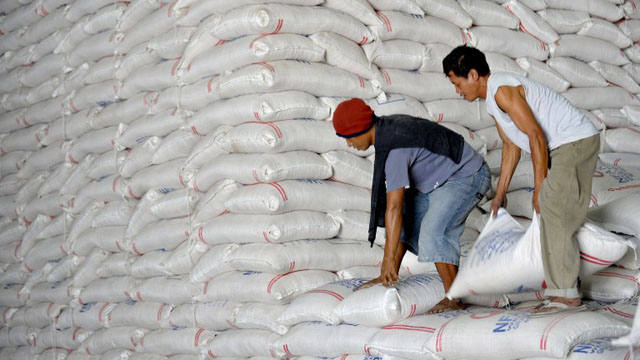SUMMARY
This is AI generated summarization, which may have errors. For context, always refer to the full article.

MANILA, Philippines – The World Trade Organization Committee on Trade and Goods (WTO-CTG) has allowed the Philippines to continue imposing high duties on imported rice, said Agriculture Secretary Proceso Alcala during a press conference on Monday, June 23.
Alcala said the WTO-CTG would endorse to the WTO General Council its approval of the country’s petition to extend the implementation of the quantitative restriction (QR) on rice until 2017.
“I am very pleased to announce the success of our rice panel which has just finished negotiations with the Committee on Trade and Goods of the WTO. Our request for waiver for special treatment on rice will be endorsed by the CTG to the WTO General Council in July,” he told reporters.
The Philippines is allowed to import 350,000 metric tons (MT) of rice annually under the Minimum Access Volume (MAV). Only rice included in this quota are levied a duty of 40%. Imports outside this quota are levied a duty of 50%.
What does this mean to the Filipino rice farmer?
Alcala said the extended QR protects farmers and the local rice industry from cheaper rice from other countries, at least until 2017. The Agriculture department pushed for the extension to build the production capability of farmers so they can cope with increased competition in Southeast Asia. (READ: PH road to rice self-sufficiency)
“Without the extension, what will happen? Rice is cheap in Thailand, rice is cheap in Vietnam. How can Juan the rice farmer compete?” he told Rappler in a separate interview.
It currently costs a Filipino farmer P11 (US$0.85) to produce one kilogram of palay. In contrast, cost of production in Thailand is P8.40 ($0.65) per kilogram . In Vietnam, it’s P5.60 ($0.43) per kilogram.
‘Temporary success’
But Alcala said he is determined not to rest on his laurels.
“This is a temporary success. What we must think of now is, before 2017 comes, what interventions can government make to ensure that our rice is competitive?”
One step being taken by the Department of Agriculture (DA) is to promote the 10-5 Challenge launched by the Philippine Rice Institute. A way to lower the cost of rice production, the challenge asks Filipino farmers to find a way to harvest 10 tons of rice from every hectare of land while spending only P5 for every kilogram of rice produced.
But Alcala gave assurances that the department would help farmers achieve this.
“I have told this to the president, if we get QR, we need to help the farmers with farm mechanization, post-harvest facilities and technology transfer. Once we give this, and also loaning money to farmers with reachable interest, we can lower the production cost,” Alcala told Rappler.
Meanwhile, critics of the DA’s petition say an extension of the QR is a breach of WTO law which seeks to promote free trade. They add that allowing the QR to expire would be good for Filipino consumers since it would make cheaper rice from other countries more accessible.
But Alcala defended the measure by saying the extra 4 years given by the extended QR allows for the strengthening of the local rice industry which would benefit local consumers in the long run.
“If rice fields in Thailand and Vietnam get flooded and we continue to depend on them for our rice, where will we get our supply? If their rice prices shoot up unexpectedly, what will happen to us?”
This is the second QR extension granted by the WTO to the Philippines. After allowing the country to impose a 10-year quota on rice in 1995, the WTO extended the quota until 2012.
Monitoring rice prices
Meanwhile, the National Food Authority (NFA) is making sure accredited rice retailers are not hiking up their prices.
Retailers caught overpricing or hoarding rice will be suspended or will have their licenses revoked, said Presidential Assistant for Food Security and Agricultural Modernization Francis Pangilinan.
To alleviate the impact of higher rice prices, the NFA plans to double its delivery of rice. From 12,500 sacks of rice delivered to markets across the country, this will be increased to 25,800 sacks. – Rappler.com
Add a comment
How does this make you feel?
There are no comments yet. Add your comment to start the conversation.